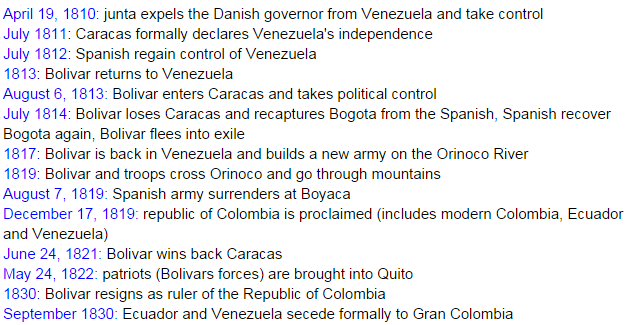 |
| This pie- chart shows the Race as Percent of the Population of Latin America. A person's race determined their social status and what rights they had. |
This week in History, we have been learning about the Latin American Revolutions. The essential question that we have been focusing on is: Why is it essential to acknowledge human value regardless of race? How are the events in the Latin American Revolutions evidence of this social imperative? This question is important to think about because it pertains to the dignity of human beings. Everyone should be treated with equal dignity and the Latin American Revolutions show evidence that this is a widespread belief. To study the Latin American Revolutions, our class looked at three specific revolutions. The revolution of Gran Colombia, Brazil and Mexico. My group began by looking at the revolution in Gran Colombia. We created a basic timeline of events based on a reading we were given. We also created a pie chart to show the race of the population. After this, we met up with the other groups who had created timelines for Mexico and Brazil’s revolutions and exchanged notes. We created simple statements that told of the similarities and differences between the three revolutions.
 |
| Our Timeline of the Revolutions of Gran Colombia. |
Our groups organized our information about the Gran Colombia revolution by creating a timeline. After exchanging notes with the groups who gathered information about the Mexican and Brazilian revolutions, we decided on two similarities between the three, and two differences. One similarity was: The mother European countries take control of their colonies and prevent them from gaining independence. In this instance, Spain was preventing Gran Colombia and Mexico from gaining their independence, and Portugal was preventing Brazil from gaining its independence. Secondly, all three countries were successful in gaining their independence from their European countries. Although this independence may have been short lived, Mexico, Colombia and Brazil were independent countries at some point during the time around when they were having revolutions, and they are all separate countries today. Next we created two statements that showed how the revolutions were different from one another.They all took place in different parts of Latin America. The revolution of Gran Colombia took place in Northwestern South America, Brazil’s revolution took place in current day Brazil, Northeastern South America and the Mexican revolution took place in present day Mexico, central America. Next, all three revolutions had different leaders fighting for independence.
The leader of the Gran Colombian revolution was Simon Bolivar. Pedro I led Brazil and Miguel Hidalgo and Augustin de Iturbide lead the Mexican revolution. In all three countries ‘race’ was an issue. In Brazil, Pedro "surrounded himself with Portuguese-born cabinet ministers." Other elites weren't allowed to be part of the government because they weren't Portuguese. Also in Mexico, "Mexicans or mixed or pure Indian blood would have lesser rights.", under the rule of Iturbide. The people of both countries who didn’t fit into these races weren’t happy. Lastly, in Gran Colombia, Bolivar came from aristocrats and was wealthy but he was raised by slaves. This changed his views to support the people who had been oppressed in Gran Colombia. People fought for independence, but they also fought for equality of race in each of their respective countries.
 |
| A map of South America that shows Gran Colombia and Brazil in 1830. To the north is Mexico. (http://www.historyworld.net/wrldhis/ plaintexthistories.asp?historyid=ab81#ixzz3IOpbzdeQ) |
Today, there are still judgments made based on race. In Ferguson, Missouri there is a situation in which a police officer shot and killed an unarmed 18 year old. An article about the situation says,
“The panel has been considering charges against Darren Wilson, the white suburban St. Louis officer who fatally shot the black 18-year-old after a confrontation in August.”
This situation would not have been such a big deal, and there wouldn’t have been as many protests if, say, a black man shot a white man, but because of race and because of the long- ago, outdated, and wrong belief that white people are superior to any other race, there is a problem in Ferguson. It is still important to consider the issue of race in our lives today. Not too long ago, in the 1960s, race was a huge issue. There was a lot of segregation, especially in the south and African American people were looked down on and treated horribly. We have come a long way since the 1960s, but we aren’t quite there yet, as proved by the issue in Ferguson.
No comments:
Post a Comment